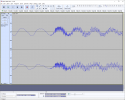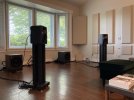Of course it works like that. You go (digitally) into the KH750 and it also has the filters for the satelite speakers. KH120ii + KH750 would be a fullrange solution down to 20Hz.If the dsp allows almost ALL the bass to play through the kh750 and the rest of the spectrum on the kh120ii, it should theoretically better than just the kh150- acting as a three way.
but I doubt that it is optimised for this (allowing higher spl without distortion).
maybe the midwoofer on the kh120ii doesn’t go loud enough as the limiting factor here.
-
Welcome to ASR. There are many reviews of audio hardware and expert members to help answer your questions. Click here to have your audio equipment measured for free!
You are using an out of date browser. It may not display this or other websites correctly.
You should upgrade or use an alternative browser.
You should upgrade or use an alternative browser.
Neumann KH120 II Monitor Review
- Thread starter amirm
- Start date
We know from Voishvillo, Geddes et al., that distortion is not a problem in electroacoustical systems. Until it is.
Also we know, that broad Q transfer function changes, even <1dB, are easily audible. (Toole, Olive et al.)
It then makes sense to measure the speakers' linear range - output level, that is not affected by transfer function change with level (no compression) and a distrotion level, that is not 'excessive'. Please take a closer look at AES75 standard. It descibes a method for excactly that.
There are consensus based tresholds in AES75, that can be ignored. Eg stop the test, when transfer function changes 1-2dB, or coherence(distortion) reaches below 95%(~10% THD) or pick a random threshold. As mentioned previously, it is a pass-fail method, that easily determines linear range. Then, if it is necessary, 'investigate futher' with detailed multi-tone testing. Please see AES Convention e-brief by Merlijn van Veen and Roger Schwenke for more detailed discussion.
Also we know, that broad Q transfer function changes, even <1dB, are easily audible. (Toole, Olive et al.)
It then makes sense to measure the speakers' linear range - output level, that is not affected by transfer function change with level (no compression) and a distrotion level, that is not 'excessive'. Please take a closer look at AES75 standard. It descibes a method for excactly that.
There are consensus based tresholds in AES75, that can be ignored. Eg stop the test, when transfer function changes 1-2dB, or coherence(distortion) reaches below 95%(~10% THD) or pick a random threshold. As mentioned previously, it is a pass-fail method, that easily determines linear range. Then, if it is necessary, 'investigate futher' with detailed multi-tone testing. Please see AES Convention e-brief by Merlijn van Veen and Roger Schwenke for more detailed discussion.
Last edited:
if the active crossovers can make it truly 3 way in this configuration it may reduce thd distortion further.Of course it works like that. You go (digitally) into the KH750 and it also has the filters for the satelite speakers. KH120ii + KH750 would be a fullrange solution down to 20Hz.
assuming the directional bass signal part doesn’t affect the mids on the 5.25 inch driver at certain spl.
- Thread Starter
- #224
I didn't know they had turned m-noise stuff into an AES standard. Are they still enforcing their branding/use of m-noise? If so, it is very odd to see it part of an AES standard. That was a major turn off for me.It then makes sense to measure the speakers' linear range - output level, that is not affected by transfer function change with level (no compression) and a distrotion level, that is not 'excessive'. Please take a closer look at AES75 standard. It descibes a method for excactly that.
Hey, fair do's! I was mainly concerned that you'd be making your hearing worse with your EQ's, but I do think that your decision to get it checked out can never be a bad thing, so yeah, good luck with that, hope it goes well.I went for coffee and a walk and thought about what you say and I've decided to take your advice and get a Dr appointment setup requesting a referral to a hearing specialist to see if my hearing is not good. Thanks for the prodding and suggestions.I'm reallly interested to see what happens.
- Joined
- May 31, 2020
- Messages
- 797
- Likes
- 1,401
The screenshot shows Lizz Wright - Barley ?What is the track?
- Thread Starter
- #227
I have reported it before. It is Fading Sun by Terje Isungset.What is the track?
I don't know how it comes across in youtube. But on anything other than a proper headphone or a speaker with very deep bass response, it either gets distorted, doesn't play loud or both. You don't even need to crank it up. Whoever says bass distortion is not audible, needs to listen to the first 30 seconds of this track!
- Thread Starter
- #228
That is a newer find with good bass but is not the standard torture track. I post it above.
dasdoing
Major Contributor
on anything other than a proper headphone or a speaker with very deep bass response, it either gets distorted, doesn't play loud or both.
my TV says there is no bass lol.
put on my headphones.
nice track, though these are basicly sine waves. the bell is also very nice for checking things. if I turn off FR compensation for my headphones it wont sound like a real bell at all. with compensation is virtually appears in front of me (or rather in my head). a shame they destroyed the vocals with those resonant effects, though I understand it's an artistic choice
Here's the spectrogram:I have reported it before. It is Fading Sun by Terje Isungset.
I don't know how it comes across in youtube. But on anything other than a proper headphone or a speaker with very deep bass response, it either gets distorted, doesn't play loud or both. You don't even need to crank it up. Whoever says bass distortion is not audible, needs to listen to the first 30 seconds of this track!I like that it is such a quick and highly instructive track. You can easily rate how good or bad the bass is.
from my guide
I did some measurements to confirm the resonance at low levels. Just a quick setup, speaker at listening position, mic at 50cm, level calibrated at 1m distance. No gating - so there is all the room influence included.
My measurements look different. Not the steep resonance at 330Hz but still, there is a leftover at 400-500Hz at low levels. When going even lower in level (70dBSpl and less) THD sinks in the noise floor (of the measurement mic).
View attachment 298823
There is also a little hump in the THD % measurement, but by far not what amirm measured.
View attachment 298824
THD at 80dBSpl from H2 and H3:
View attachment 298825
I first thought about noise artefacts but it probably isn't. Not sure what's going on.
@amirm - can you repeat your 80dBSpl measurement, probably with a different speaker? What does Neumann say to your data? And can you show a logarithmic THD scale - with these low distortion speakers the linear scale lacks information. And humans don't work linear - we are logarithmic people
So I can not confirm the spike at 330Hz from these measurements but there is probably some small effect going on here. But at 0,2% THD I would not overestimate this effect.
These resonances at low levels around 300-500Hz are usually cabinet/panel related.
They appear worse than they sound, because they are usually buried beneath the noise floor of the listening room. As SPL increases, the vibrational modes of the walls changes.
It takes Herculean efforts to eliminate all cabinet resonances, and really drives up the cost of manufacturing and end-cost for the consumer. When cabinets are REALLY bad, you get things like this-
- Joined
- Jul 23, 2019
- Messages
- 532
- Likes
- 564
An Audacity-based spectrum analysis of the entire track "Barley" by Lizz Wright produces a low-frequency peak located at 38.8 Hz:

An Audacity-based spectrum analysis of the entire track "Fading Sun" by Terje Isungset produces a low-frequency peak located at 33.0 Hz:

An Audacity-based spectrum analysis of the entire track "White Teeth Teens" by Lorde produces a low-frequency peak located at 29.3 Hz:

An Audacity-based spectrum analysis of the entire track "Bass I Love You" by Bass Mekanik produces three significant low-frequency peaks, which are located at 30.4 Hz, 17.2 Hz, and 8.4 Hz:

An Audacity-based spectrum analysis of the entire track "Fading Sun" by Terje Isungset produces a low-frequency peak located at 33.0 Hz:
An Audacity-based spectrum analysis of the entire track "White Teeth Teens" by Lorde produces a low-frequency peak located at 29.3 Hz:
An Audacity-based spectrum analysis of the entire track "Bass I Love You" by Bass Mekanik produces three significant low-frequency peaks, which are located at 30.4 Hz, 17.2 Hz, and 8.4 Hz:
dasdoing
Major Contributor
dc offset?
dasdoing
Major Contributor
lot's of clipping, right here for example:
not sure if the distorsion of that synth at the beginning is wanted. sounds dirty
not sure if the distorsion of that synth at the beginning is wanted. sounds dirty
- Joined
- Jul 23, 2019
- Messages
- 532
- Likes
- 564
I don't think that there is any clipping, as I can't see any flat-topping of the waveform when zoomed in. The bass level is being very carefully controlled, going by the low-frequency waveforms.lot's of clipping, right here for example:
Is the following waveform in the the region that contains the sound signature that you're referring to? It's evident that there is a rapid onset of some higher-frequency content, including some triangular waveshapes riding along on the underlying bass signal. Would that explain the "dirty" sound?not sure if the distorsion of that synth at the beginning is wanted. sounds dirty
Attachments
Not in AES75-2023 anymore! We all can freely use 'Music Noise'. AES even provides the generated noise as a free download: https://www.aes.org/standards/models/Are they still enforcing their branding/use of m-noise?
@JohnPM had issues with incorporating this signal in REW because of that. Yes - unlike pink-noise, we can't generate it ourselves due to issues only known to AES (repeatability? Still some IP issues?). But the beaty of Music Noise lies in the high crest factor >~3000Hz, below it is identical to pink.
Qobuz says "Not possible to play this track". Too dangerous for drivers?I have reported it before. It is Fading Sun by Terje Isungset.
I don't know how it comes across in youtube. But on anything other than a proper headphone or a speaker with very deep bass response, it either gets distorted, doesn't play loud or both. You don't even need to crank it up. Whoever says bass distortion is not audible, needs to listen to the first 30 seconds of this track!I like that it is such a quick and highly instructive track. You can easily rate how good or bad the bass is.
i played this track with 120ii & 750...wow...the bass!Qobuz says "Not possible to play this track". Too dangerous for drivers?
Attachments
Nice. What stands are thosei played this track with 120ii & 750...wow...the bass!
Also how much was the benefit instead of one sub
Similar threads
- Replies
- 56
- Views
- 15K
- Poll
- Replies
- 432
- Views
- 85K
- Replies
- 14
- Views
- 2K
- Replies
- 359
- Views
- 72K
- Poll
- Replies
- 791
- Views
- 81K

